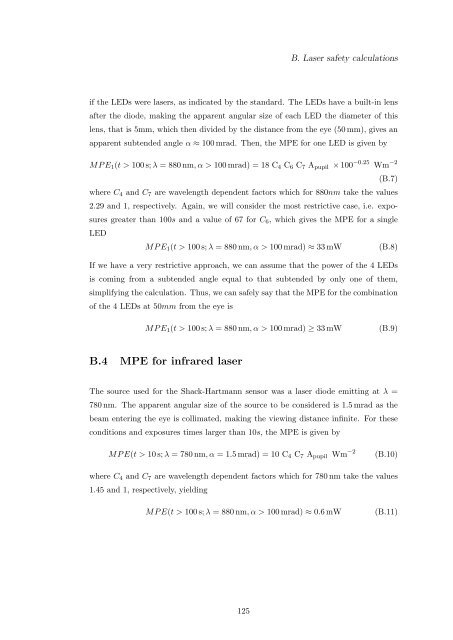Alfredo Dubra's PhD thesis - Imperial College London
Alfredo Dubra's PhD thesis - Imperial College London
Alfredo Dubra's PhD thesis - Imperial College London
You also want an ePaper? Increase the reach of your titles
YUMPU automatically turns print PDFs into web optimized ePapers that Google loves.
B. Laser safety calculations<br />
if the LEDs were lasers, as indicated by the standard. The LEDs have a built-in lens<br />
after the diode, making the apparent angular size of each LED the diameter of this<br />
lens, that is 5mm, which then divided by the distance from the eye (50 mm), gives an<br />
apparent subtended angle α ≈ 100 mrad. Then, the MPE for one LED is given by<br />
MP E 1 (t > 100 s; λ = 880 nm, α > 100 mrad) = 18 C 4 C 6 C 7 A pupil × 100 −0.25 Wm −2<br />
(B.7)<br />
where C 4 and C 7 are wavelength dependent factors which for 880nm take the values<br />
2.29 and 1, respectively. Again, we will consider the most restrictive case, i.e. exposures<br />
greater than 100s and a value of 67 for C 6 , which gives the MPE for a single<br />
LED<br />
MP E 1 (t > 100 s; λ = 880 nm, α > 100 mrad) ≈ 33 mW (B.8)<br />
If we have a very restrictive approach, we can assume that the power of the 4 LEDs<br />
is coming from a subtended angle equal to that subtended by only one of them,<br />
simplifying the calculation. Thus, we can safely say that the MPE for the combination<br />
of the 4 LEDs at 50mm from the eye is<br />
MP E 1 (t > 100 s; λ = 880 nm, α > 100 mrad) ≥ 33 mW<br />
(B.9)<br />
B.4 MPE for infrared laser<br />
The source used for the Shack-Hartmann sensor was a laser diode emitting at λ =<br />
780 nm. The apparent angular size of the source to be considered is 1.5 mrad as the<br />
beam entering the eye is collimated, making the viewing distance infinite. For these<br />
conditions and exposures times larger than 10s, the MPE is given by<br />
MP E(t > 10 s; λ = 780 nm, α = 1.5 mrad) = 10 C 4 C 7 A pupil Wm −2<br />
(B.10)<br />
where C 4 and C 7 are wavelength dependent factors which for 780 nm take the values<br />
1.45 and 1, respectively, yielding<br />
MP E(t > 100 s; λ = 880 nm, α > 100 mrad) ≈ 0.6 mW<br />
(B.11)<br />
125

















